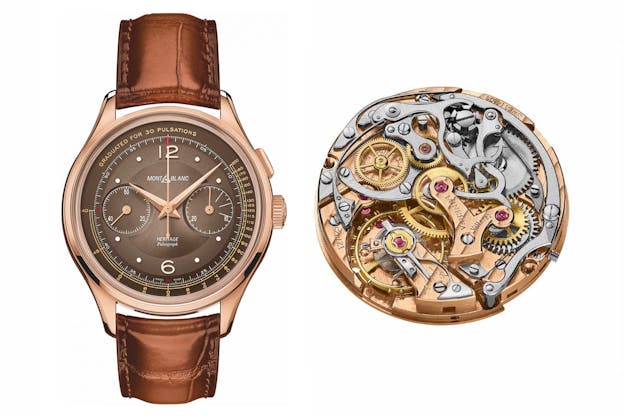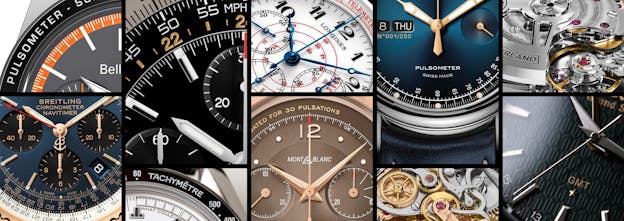How to Read a Watch Bezel
A watch bezel may be graduated, feature a tachymeter scale, calculation or diving functions, or GMT. Bezels form a major part of a watch’s personality. But here’s the thing: very few people actually use them, even though it’s not that complicated to do so. It’s time for a brief how-to guide.
Is the bezel the watch’s poor relation? It sustains bumps and absorbs impacts on a daily basis, revolves in all directions, displays a whole host of information, and never complains, so it’s tempting to conclude that it could well be just that.
The bezel tends to be relegated to the role of a merely decorative item, but it is in fact a central part of a watch’s identity, probably second only to the dial. Like the dial, it forms part of the timepiece’s style signature; like the dial, it can provide extensive information about time measurement. And yet it is forever being misunderstood, since it sometimes calls for a spot of mental arithmetic, something most of us are no longer used to doing. And admittedly, brands rarely supply instructions for its use.
Watches & Speed Trials
There’s no need to be intimidated, though. The easiest is the GMT scale. This simply has 24-hour graduations, rather than a dial with 12-hour graduations. That’s not too complicated. The tachymeter scale, meanwhile, can be used to provide the information a speedometer would show. It’s child’s play to use. You just need to know two things. Firstly, the watch’s second hand is used for the measurement. Secondly, the timer needs to be activated from point A to point B, using the scale shown on the bezel.
In the vast majority of cases, tachymeter scales are in base 1000 (metres). The chronograph must be activated at a given point A and stopped at a given point B, 1000 metres away on the scale. The speed of movement is thus directly indicated by the second hand on the bezel.
If the speed of the object measured is very slow (little more than a few dozen kilometres per hour), the second hand will complete two rotations rather than one. This calls for a double scale bezel, which is quite rare. One such example is the Navitimer. If the chronograph’s second hand covers 110 seconds (60 + 50), the speed measured is 40 km/h, as shown by the red-tipped hand.
Closer to the Heart
The ‘doctor’s watch’ works more or less according to the same principle (although it is nothing like the nurse’s watch, typically a fob watch; Tissot is one of the last firms to make these). It is a pulsometer: a watch equipped with a chronograph featuring a graduated bezel, generally based on 30 heartbeats. Graham and Montblanc still have some for sale. Practically speaking, to calculate your heart rate, you simply need one hand to take your pulse and count its beats whilst operating the chronograph. Count 30 beats and stop the chronograph; the position of the hand on the graduated scale indicates the number of beats per minute.


A Thunderbolt in the World of Watchmaking
The telemeter, which has enjoyed a renaissance thanks to vintage being in fashion, follows the same principle. It can be used to evaluate the distance of an event based on the when the wearer hears the sound it makes. This too requires a central second hand or a chronograph. All you need to do is to engage it when you see, say, a flash of lightning, and stop it when you hear the thunder: the second hand will indicate how far away the storm is. Longines still offers some of these watches, easily identifiable by the red spiral on their dial, which provides a whole range of measurement scales.

Navitimer: Easier Than it Looks
There remains the case of the Breitling Navitimer, whose bezel is not a scale but a slide rule. Simply put, this allows the result of certain calculations (such as multiplication) to be read off without needing to resort to mental arithmetic.

The rule comprises two bezels. The first one, on the outer edge of the dial, rotates and is graduated in intervals of 10. The second one beneath it is fixed and is marked in increments of one; the third one below that is often just a conventional tachymeter, as described above, though there are many different Navitimer versions with various types of scales.

The basic idea is simple: the figure above the ‘10’ index on the outer bezel indicates the required result. For example, to multiply 7 by 12, you place the 12 on the outer scale opposite the 10 on the inner scale. The result appears opposite the first figure (7): 84.
Divisions are even easier: you just place the two figures you want to divide one above the other; you can read off the result directly, opposite the 10. Various aviation-related calculations can be performed, too: fuel consumption, flight time, ground speed, wind effect, and converting various units of measurement: nautical miles to kilometres, gallons to litres, kilograms to pounds, degrees Celsius to Fahrenheit, and more besides – even if the venerable Navitimer has long been replaced by Garmins and Dynons on actual aircraft instrument panels.

